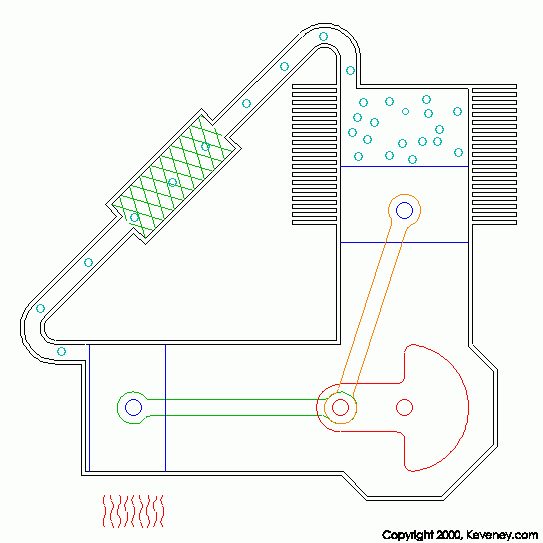
One ordinarily meets the
following Stirling engines :
- « alpha type
» Engines : it uses 2 cylinders at 90°
ith an oscillating piston in each cylinder. Each piston is attached to
an unique brace and crankshaft whose the axis of rotation is at the
intersection of the two axes of the cylinders. Thus the pistons are
oscillating in quadrature. These engines are usually equipped with a
regenerator which takes place between the 2 heads of cylinder. They
don't require. any moving fluid piston. By example, they are currently
industrialized by the german company SOLO (Singelfinden) for output
powers of approximately 10 kW in the setting of solar facilities like
the
« Dish Stirling » power-plants.


Stirling motor SOLO161 10kW
Numerous and nice animations (steam engins, various motors...) to see on www.keveney.com

Animation above taken from www.moteurstirling.com
Author: Pierre GRAS
One Dish Stirling solar facility
with alpha Stirling engine
(click to know more)
Project Eurodish, motor
SOLO161 10kW electrical,
diameter of the du
collecting mirror : 8,5 m
- «
type 'in series' pistons » engine : it requires
to put in series N pistons, usually, pushed by N rods and by one common
crankshaft. On the crankshaft, the phasing betwenn 2 consecutive braces
is about 90°, in order to make them to oscillate in quadrature.
Betwenn 2 consecutive pistons is placed one regenerator. The pistons
are "double effect", as they can working on their 2 sides : thus there
are N distinct volumes of coolant fluid. The k-th volume passes in
transit
only and incessantly betwenn the k-th and k+1-th engines via the k-th
regenerator.
The heads of the cylinders
(« top engine ») are usually the hot source and the
feet (« bottom engine
») are the cold source, altough it's
possible to do the inverse.


- «
beta
type
»
engine with simple roding : they use only one cylinder in
which both a "working" piston and a "moving fluid" piston are sliding.
These 2 pistons are connected on the crankshaft by 2 rods, attached on
2 braces, which are baffled of 90°. The working piston is
recovering the mechanical power while the moving fluid piston
allow to evacuate it periodically, at an approximately constant volume,
from the hot zone to the cold zone and inversely. This displacement of
fluid makes itself of preference via a regenerator mounted on the flank
of the cylinder.

Numerous and nice animations (steam engins, various motors...) to see on www.keveney.com
- « beta type
» engine with rhombic roding (or rhomboïd)
: it works as the simple roding, but with a roding
based on a deformable lozenge, which allow to
better pilot the "moving fluid" piston and the "working" piston: thus
it can have an approximately constant volume during
the ideally isochoric times.
- «
gamma
type
» engine
: it uses 2 cylinders and 2 pistons which have each their
own actuator. Each piston is both "moving fluid" and "working piston.
One regenerator can be mounted on the flank. The
synchronization between the pistons is making itself notably by
gearings, chains, straps and/or rodings. The "gamma type" engines can
be seen as an hybridization between the "alpha" and "beta" types..
In complement of these usual engines exist non conventional Stirling engines,
less known, staying at the prototype step, or designed for very
specific applications (spatial...):

- free piston engine
« Martini type
» : the working piston is sliding according to the pressure
in the motor. When the pressure raises, it is pushed in a way. When the
pressure collaps, it is pushed in the other way until its initial
position. It requires an average strength on the external side of the
piston ; it is generated by a gas
shut in a bottle or by the tarage of a spring. If the working
piston is a magnet, one can install around a linear alternator and
generate electric power.

- free "moving fluid" piston engine
« Ringbom type
» :
on the contrary, the working piston is mechanically actuated. But the
moving fluid piston is sliding according to the pressure of the gas
shut in a bottle and the pressure of the motor.

- « free pistons type
» engines : they make the synthesis between the two previous
engines. There is no mechanical joint with the exterior. The produced
power is recovering by at least one linear alternator.

Some examples of free pistons Stirling's engines designed and built in the USA :

- Thermoacoustic
engine : modernized approach of the previous free pistons,
it uses a thermal gradient betwenn the 2 extremities of a pipe which
contains a porous membrane and a gas. A system of acoustic waves takes
place in the pipe, generating a sound convertible into electricity by
a microphone.

- Rotary
engine, in a sensibly elliptical surrouning wall : a 4
quadrants vision, with a cold/hot alternation between 2 consecutive
quadrants, is isolating 4 rooms inside the ellipse (with a rotor having
four surfacic, tangent and permanent contacts on the ellipse). The
relative rotation between the rotor and the ellipse entails dilatations
and contractions for the gas which generates some mechanical power: an
example is the Quasiturbine Stirling shown by the SAINT HILAIRE's
Family.
4 poles Quasiturbine
Stirling concept


Author : Pierre GRAS
Author : SAINT HILAIRE's Family www.quasiturbine.com

























